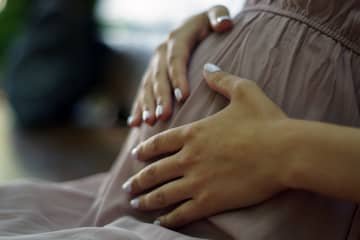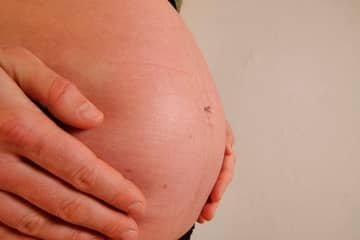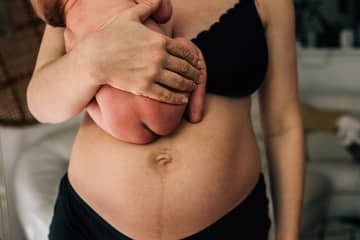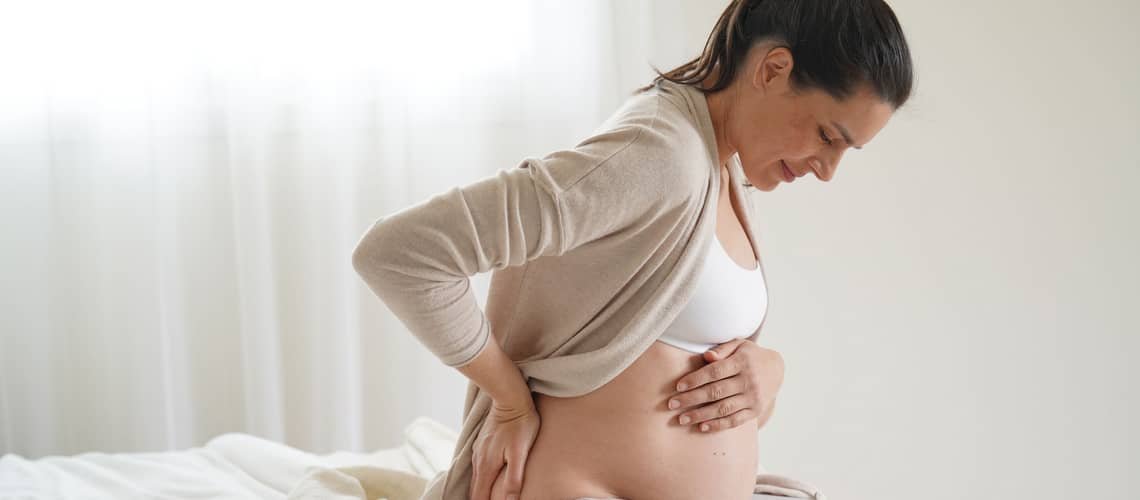
Signs of childbirth. Contractions and other signs of impending birth
Each stage of pregnancy is characterized by certain symptoms indicating the gradual development of a new life in the mother's womb. Even the third trimester of pregnancy can really shake the female body, and therefore at this time many pregnant women begin to carefully monitor even the smallest change in the body, which could indicate that they are approaching the long-awaited goal line. However, it should be remembered that some signals of the organism are classified "only" as signs of childbirth, which should occur in the near future.
In the article, we deal with various symptoms of impending childbirth, which can sometimes be related to real symptoms of the body indicating the onset of labor. We believe that a summary of the most common signs about the proximity of the baby's arrival date will help prepare future parents for the big pregnancy finale.
The first signs of impending birth
The third trimester of pregnancy is the time when a woman's body prepares for childbirth. In this way, several processes are started in the body of a pregnant woman, which indicate that there is a gradual adaptation to the necessary requirements of the last stage of pregnancy, and therefore childbirth.
While some symptoms of labor are manifested long-term during the entire third trimester, others are specific to the period of the last days before childbirth. From the point of view of a pregnant woman, it is necessary for her to be aware of the individual signs of impending birth. Sometimes they can be very easily mistaken for symptoms of labor in progress.
Even in this issue related to pregnancy, however, the individuality of each case applies. While some pregnant women can notice specific pre-natal signals for several weeks, for others they appear only a few hours before the birth itself. It is also possible that there is no sign of childbirth, which puts these pregnant women right in front of a done deal.

Change in the body's center of gravity and lower back pain
As the due date approaches, a pregnant woman may notice certain signs that the fetus itself is adjusting to the final phase of its stay in the womb. At this time, the fetus descends into the pelvic area, preparing it for its journey through the birth canal.
This phenomenon is typical for the last month or final two to four weeks of pregnancy. As part of the symptoms of childbirth in the second mother, or a more experienced pregnant woman may experience the descent of the fetus into the birth canal in the later stage of the third trimester, a few days before delivery. The descent of the uterus causes not only the relief of some internal organs of the pregnant woman, which were under considerable pressure for the majority of the pregnancy, but also a change in the center of gravity manifested by a peculiar gait similar to a penguin.
The adaptation of the internal anatomy of a pregnant woman to the approaching birth is made possible by the increased level of the hormone relaxin, which is responsible for relaxing the muscles and joints to facilitate the passage of the baby through the pelvis. However, this hormone is also responsible for impaired body coordination and difficult movement in the last weeks of pregnancy.
"Penguin walk" is caused by the pressure of the baby on the pelvis, as a result of which the posture of pregnant women expands. Women have to quickly get used to this changed center of gravity in order to be able to coordinate their movements adequately. However, it is not that simple. Changes in the center of gravity are also reflected in back pain, most often in the lumbar region. This unpleasant phenomenon is therefore the result of natural physiological changes that potentially lead to an easier course of childbirth.
The pressure of the head on the pelvis adds another uninvited guest to the prenatal equation, in the form of hemorrhoids. It is advisable for pregnant women to get used to this unpleasant feeling that accompanies hemorrhoids as soon as possible, because they are most likely to reappear after a natural birth.
Freer and easier breathing
The aforementioned lowering of the baby into the pelvic area can significantly contribute to the relief of some basic systemic processes of the pregnant woman's body. These include, for example, breathing. As the uterus descends, space is freed up for the lungs and diaphragm, which leads to freer breathing. Thanks to this phenomenon, one of the most common causes of shortness of breath in pregnant women is eliminated in the third trimester. However, this does not mean that a woman will completely get rid of the feeling of exhaustion.

Frequent urge to urinate
While the internal organs in the chest area literally take a breather, those in the lower part of the pregnant woman's body get a good job. This applies especially to the bladder, which is subjected to greater pressure due to the decrease of the uterus. In addition to the random movements and kicks of the fetus in this organ, another force is added, which forces the woman to visit the toilet frequently.
A natural part of the last trimester of pregnancy is the spontaneous leakage of urine, which must be distinguished from the outflow of amniotic fluid. While urine is characterized by a yellowish color and a smell familiar to everyone, amniotic fluid is transparent and does not have any specific smell. A huge difference between amniotic fluid and urine lies in the ability of a pregnant woman to hold back their outflow. While it can prevent the leakage of urine in spite of the relaxed pelvic muscles, it will not stop the amniotic fluid under any circumstances.
Prenatal diarrhea and a newfound appetite
Antepartum diarrhea is also one of the first signs of impending birth. While some women have problems with digestion during the entire pregnancy, others experience problems with digestion of this nature until the end of the third trimester. The hormone relaxin, which acts on the muscles of the anus, is also responsible for diarrhea before childbirth. This causes diarrhea, which can lead to dehydration of the body. Therefore, pregnant women should take in as much fluid as possible, while the aforementioned frequent urination should not deter them from doing so.
Diarrhea can easily be caused by a newly discovered appetite, which is created by the relief of the digestive system due to the descent of the uterus into the pelvic area of the female body. A pregnant woman may get the feeling that her digestive problems in the form of heartburn are over, but this may not be the case for everyone.
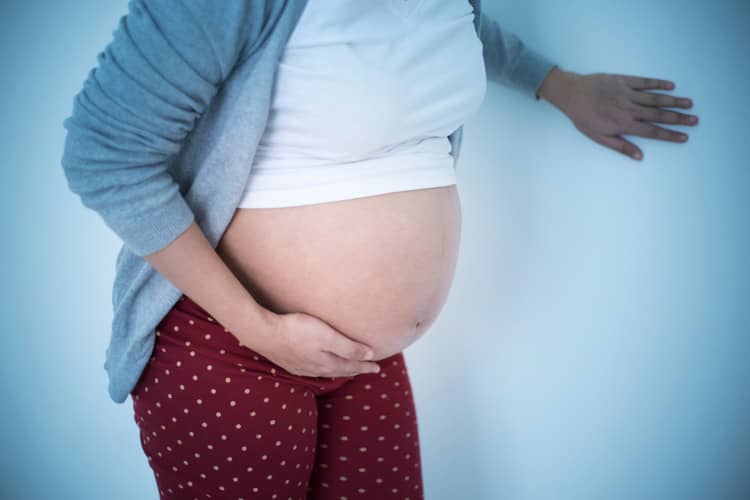
Alternation of exhaustion and nesting instinct
The internal preparation of the female body for the upcoming birth can easily be reflected in the physical and mental exhaustion of the pregnant woman. This fact is completely natural due to the ongoing changes and pains accompanying the third trimester of pregnancy and there is no need to resist it. Therefore, it is necessary to use any chance to rest.
However, for the last three to four weeks of pregnancy, a specific phenomenon called the " nesting instinct" is characteristic, which consists in the detailed preparation of the household for the arrival of a new family member. This category of activities includes major house cleaning, checking the necessary equipment, but especially washing, ironing, folding and subsequent organization of children's clothing. Nesting is largely related to the hormonal changes that a pregnant woman goes through before giving birth, and this phenomenon is characteristic of all mammals, and thus not only of humans.
Regardless of whether a pregnant woman belongs to the category of energetic women before giving birth or rather to those who are exhausted, first of all it is necessary for her to listen to her body. This will play a significant role in the birth itself, which requires the highest possible level of physical and mental well-being.
Changes in vaginal discharge
Initial signs of labor include a change in color, consistency, and amount of vaginal discharge. In the last weeks before giving birth, a pregnant woman may register the release of a more watery or, conversely, thicker secretion. At the same time, it may have hints of stickiness and a pinker color caused by blood admixture. If a pregnant woman notices a higher content of blood in the vaginal discharge, it is necessary to contact her doctor immediately. Vaginal bleeding before childbirth is a sign of complications that must be identified as soon as possible.
Such a vaginal discharge indicates to a woman that her genital system is preparing for the birth process. In the case of some pregnant women, there may be uncomfortable stabbing pains in the vaginal area. The reason is the sensitive nerves on which the lowered uterus creates a noticeable pressure.
Pregnant women are advised to wear sanitary napkins due to more frequent discharge. They are also beneficial if a woman suspects premature birth. Based on the discharge caught on the insert, doctors can determine whether it is normal vaginal secretion or gradually draining amniotic fluid.
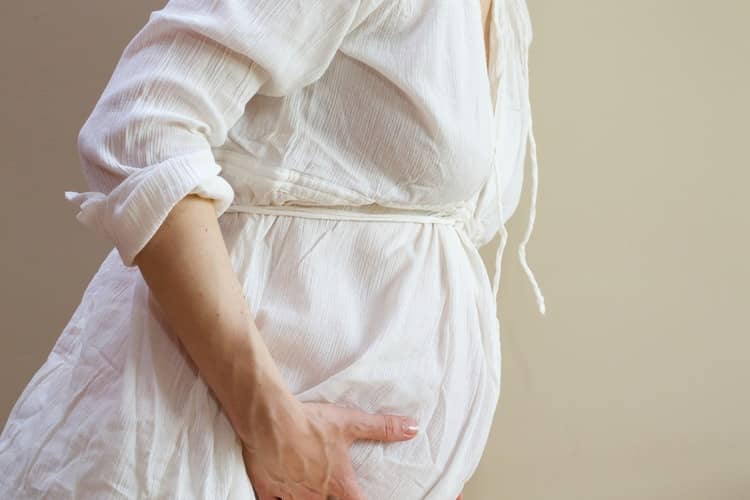
Departure of the mucus plug
However, the release of an excessive amount of vaginal discharge can also be related to the departure of the mucus plug, which during the entire pregnancy prevents the passage of infections and bacteria to the baby. It is located in the area of the cervix, where it performs its function of protecting the cervix itself, the uterus and the fetus.
As a result of the impending birth, it is released. While in some pregnant women this mucus-like secretion leaves all at once, in the case of others, the plug gradually loosens in smaller pieces. Therefore, a pregnant woman may not even notice the drainage of the mucus plug. However, the mucus plug is sometimes released only during childbirth. Some women may even mistake the discharge of the mucus plug for amniotic fluid, but there are certain characteristic features of these secretions that make them easy to distinguish.
While the amniotic fluid is watery and clear, the mucus plug has a thick consistency, and its color depends on a number of factors. Most often, it is white, pink or gray-green in color. Although a darker red color is also not excluded, which is caused by the admixture of a smaller amount of blood in the mucous plug due to changes in the cervix before childbirth.
However, it should be remembered that labor does not have to immediately follow the departure of the mucus plug. While some women give birth within a few hours after the plug is released, others expel the mucus plug two weeks before giving birth. The departure of the mucus plug is therefore classified as a symptom of impending birth.
Physiological changes of the cervix before childbirth
The aforementioned loosening of the mucus plug is largely related to the preparation of the pregnant woman's genital system for childbirth. It begins to flow at the time when there are physiological changes in the area of the cervix. As a result of the aforementioned pregnancy hormone relaxin, the muscles in this area relax, which leads to the gradual opening of the cervix. The muscles and tissues soften in this area, making it easier for the fetus to pass through the birth canal.
Shortening and opening of the cervix in many cases signals that the long-awaited birth is already at the door. Although sometimes there may be situations where the gradual opening of the vaginal opening begins several weeks before the due date. If the opening is accompanied by contractions, there is a risk of premature birth.
In the event that the opening of the cervix occurs, for example, in the sixth month of pregnancy, the doctor orders the woman to rest because of the potential for premature birth or other complications. In such a situation, hospitalization in a hospital is likely, where the cervix is sutured again. Also for this reason, we include changes in the cervix among the symptoms of childbirth. Every woman's body is different, and therefore the opening and shortening of the cervix occurs at different speeds. If it opens quickly, it is possible that the birth will occur within two days. Although it is also possible that the baby will be born a week after the first signs of dilatation of the cervix.

Messengers can easily confuse a pregnant woman
Messengers, also known as Braxton-Hicks contractions, are signs of labor that can make a first-time mother believe that it is time to give birth. However, the opposite is true. These false contractions can appear one to three weeks before the birth itself, and they most often occur in the early evening or at night.
First of all, the intensity, frequency and accompanying symptoms of false contractions of the uterus should be noted. On the pain scale, they can be compared to menstrual pains and, unlike real contractions, they are not characterized by frequency regularity. In terms of pain, there is an alternation of intensity rather than a gradual increase in their strength. If a pregnant woman feels such pains, it is good to keep calm and start tracking the pain. Based on the irregular frequency, it is possible to state the presence of false contractions.
Braxton-Hicks contractions are not characterized by any side symptoms in the form of lower back or back pain. However, if the woman cannot distinguish the pains from real labor pains, it is recommended to apply a warm shower to the lower abdomen and spine. Due to the influence of warm water, the action of the messengers will disappear.
Feelings before childbirth
While the above-mentioned physiological changes were classified more as signs of impending birth and thus the preparation of the woman's body for the birth process, the signs of birth (such as contractions and the outflow of amniotic fluid ) are clear signals that labor has begun.
Drainage of amniotic fluid requires transfer to the delivery room
The outflow of amniotic fluid causes the rupture of the amniotic membrane, in which the unborn baby was located during the entire pregnancy. However, labor starts before the amniotic fluid drains. This physiological phenomenon signals the real necessity of going to the maternity ward.
The amount in which the amniotic fluid drains largely depends on the location of the rupture of the amniotic membrane. While in some cases there is a typical outflow of amniotic fluid shown in movies in one sudden and intense stream, in other cases the amniotic fluid escapes gradually.
Also for this reason, women are recommended to use sanitary napkins in the last weeks before giving birth, while it will not hurt if they put a towel on the bed. For some pregnant women, the amniotic fluid does not drain even though their labor has actually started. The obstetrician then has the rupture of the amniotic membrane under his control. The outflow of amniotic fluid means that the main stage of labor should potentially occur in the next 24 hours. Therefore, there is no need to hesitate about going to the maternity ward. And even if the pregnant woman does not feel contraction pains typical of childbirth.

How do labor pains start?
Since we have already characterized false contractions in the previous paragraphs of the article, we should also answer the question "how do I know that I have contractions?". Unlike messengers, the real contractions accompanying childbirth are significantly more intense, while their regularity is also essential.
Associated symptoms of labor contractions include especially severe pain in the abdomen and back, most often in the sacral region. Unlike fake contractions, a warm shower won't help with real ones. In order for the woman to be able to identify them, it is necessary to note again the intensity and frequency of pain attacks. These factors will also interest the doctor upon arrival at the maternity hospital.
Real contractions of the uterus accompanying childbirth are characterized by the increasing strength of the pains, while the time intervals between individual contractions decrease due to the approaching birth. While initially the pains last for approximately 15 to 20 seconds, with 20-minute rest intervals between them, as the birth approaches, the duration of the pains increases and the break between them shortens.
If, within one hour, a pregnant woman notices regular repetition of contraction pains every 10 minutes, it is recommended to go to the hospital. Despite the fact that labor pains in such a wording seem downright scary, the truth is that they have a huge merit in accelerating the dilatation of the cervix. The faster the individual bouts of contraction pains come together, the sooner the mother will have after childbirth.
Symptoms of childbirth in a first-time mother - experience
Naturally, the experience of childbirth differs from woman to woman, while this observation is also related to the issue of the initial symptoms of childbirth. While one mom in question had an asymptomatic prenatal period and gave birth a few days after her doctor told her the baby wouldn't arrive anytime soon, the other had extremely intense bouts of contractions, after which she gave birth within three to five hours.
Some discussants noted that during the last three days before giving birth, their mucus plug gradually drained away. Others emphasized that real contractions may not always be regular. However, their intensity speaks for itself and it is necessary to go to the maternity ward immediately.
The most frequent questions - FAQ
In connection with the symptoms of labor, we clarified other interesting aspects of this issue in the question and answer section, while for any other additional questions or comments from our readers, a constantly monitored comment section is available.
What are the symptoms of preterm birth?
What is the hormone relaxin responsible for?
How much does the cervix have to open for the fetus to pass through?
Can premature rupture of the fetal membrane occur?
Pridať komentár


